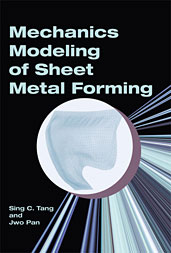Journal Article
Development of Empirical Shear Fracture Criterion for AHSS
2010-04-12
2010-01-0977
The conventional forming limit curve (FLC) has been widely and successfully used as a failure criterion to detect localized necking in stamping. However, in stamping advanced high strength steels (AHSS), under certain circumstances such as stretching-bending over a small die radius, the sheet metal fails much earlier than predicted by the FLC. This type of failure on the die radius is commonly called “shear fracture.” In this paper, the laboratory Stretch-Forming Simulator (SFS) and the Bending under Tension (BUT) tester are used to study shear fracture occurring during both early and later stages of stamping. Results demonstrate that the occurrence of shear fracture depends on the combination of the radius-to-thickness (R/T) ratio and the tension/stretch level applied to the sheet during stretching or drawing. Based on numerous experimental results, an empirical shear fracture limit curve or criterion is obtained.

